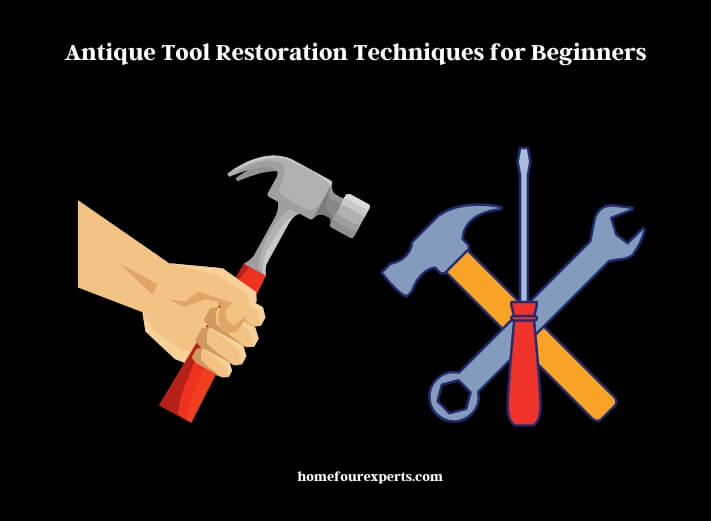Antique tools aren’t just relics of a bygone era, they’re works of art and a testament to human ingenuity. They whisper tales from our collective past and, in their aged charm, breathe life into our modern world. But what if those charming relics are losing their luster? If you’ve ever wondered, “What are some antique tool restoration techniques for beginners?”, you’re in the right place. Let’s get into it!

Why Antique Tool Restoration?
Remember the old saying, “they don’t make ’em like they used to”? Well, in the case of antique tools, it’s more than a catchy phrase—it’s true! Today’s factory-produced tools often can’t match the craftsmanship and quality of older, hand-forged tools. Antique tool restoration preserves this history and quality craftsmanship for future generations to appreciate.
Antique Tool Restoration Techniques for Beginners
Restoring antique tools is part science, part art, and part detective work. Here’s a beginner’s guide to get you started.
Identification and Research
Identifying the tool and researching its history is the first step. Websites like Wikipedia can be a valuable resource for historical and factual information. But why is it important? Well, knowing the tool’s history can help you understand its function, material composition, and ideal restoration methods.
Initial Cleaning
Cleaning is a vital step. It can be as simple as dusting off the tool or as intricate as delicately scrubbing every nook and cranny. But remember, always start gentle—you wouldn’t want to cause further damage!
Rust Removal
Got a rusty tool? Don’t fret, there’s a solution! There are a variety of methods for rust removal, including manual scraping, chemical treatments, or electrolysis. But, remember, always prioritize safety when working with tools and chemicals!
Repairing and Replacing Parts
Broken handle? Loose parts? Repairs and replacements are part of the restoration process. Keep in mind, though, if a part needs replacing, try to match the replacement to the original as closely as possible.
Polishing and Finishing
The final step in the restoration process is polishing and finishing. This brings back the original shine and helps protect the tool from future damage.
FAQs About Antique Tool Restoration
Antique tool restoration can be a daunting task for beginners. Here are some commonly asked questions that might help you along the way:
How do I identify an antique tool?
Identification can be done through markings, manufacturer’s stamps, or distinctive features. Historical guides and online resources can also help in identification.
What are the Differences Between Setting Up a Gaming YouTube Channel and Restoring Antique Tools?
Setting up a gaming YouTube channel requires high-quality video equipment, engaging content, and consistent uploads to attract a loyal audience. Restoring antique tools, on the other hand, demands patience, attention to detail, and a deep understanding of the tools’ history and craftsmanship. The complete gaming channel guide can help navigate the unique challenges of starting a gaming channel.
What should I do if I can’t remove rust manually?
If manual rust removal isn’t working, consider using a chemical rust remover or electrolysis. Always follow safety guidelines when using these methods.
How can I replace parts without affecting the tool’s antique value?
When replacing parts, aim to match the replacement as closely as possible to the original. Use similar materials and try to maintain the tool’s original aesthetic.
How can I preserve my restored antique tool?
Preserving your restored tool involves proper storage and regular maintenance. Store tools in a dry, controlled environment and regularly check for signs of damage or wear.
Conclusion
Antique tool restoration is a journey of discovery, patience, and respect for the past. It’s about preserving the stories etched in the weathered wood and rusted metal. So, if you’ve ever wondered about antique tool restoration techniques for beginners, now you know – it’s a process that requires care, patience, and a deep appreciation for the craftsmanship of the past.
Remember, every tool has a story to tell, a history to reveal, and a future to forge. So, roll up your sleeves, grab your newly-restored tool, and let’s write the next chapter in its story together. Happy restoring!
Additional Resources for Antique Tool Restoration
There are numerous resources online that can help you further in your journey into antique tool restoration:
- Antique Tools and Hardware Collectors: A community of antique tool collectors and restorers.
- Antique Tool Restoration Forums: A place to ask questions and share restoration tips.
- Antique Tool Restoration YouTube Channels: A variety of restoration tutorials for visual learners.
- National Tooling Museum: A repository of antique tools and their histories.
Final Words
Antique tool restoration is a beautiful hobby and an important way to preserve our history. The process might seem complex at first, but as the saying goes, “Rome wasn’t built in a day”. With patience, determination, and a willingness to learn, you’ll master these techniques and find yourself immersed in a fascinating world of restoration. So, why wait? Start your journey into antique tool restoration today.
Read more:
- Building the Ultimate Self-Sustaining Tool Shed
- Eco-Friendly Crafting: Sustainable Projects to Help You Reduce Waste
- Discover the Best Gardening Tools for a Lush and Beautiful Garden
- The Ultimate Guide to Types of Automotive Tools
About This Writer

Hi, I am Eric Devin and I am a professional interior architect. Since childhood, I've always enjoyed DIY projects! And, I have loved to solve simple household problems using essential tools and equipment. I have also acquired a lot of information about basic household tools settings by working with contractors.